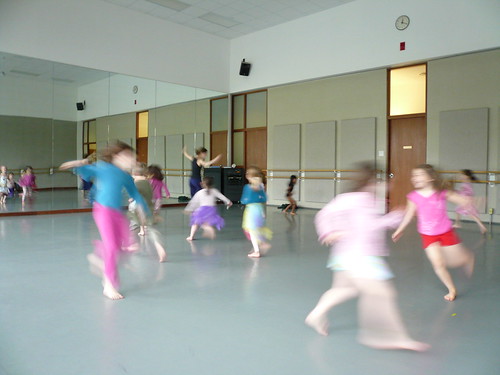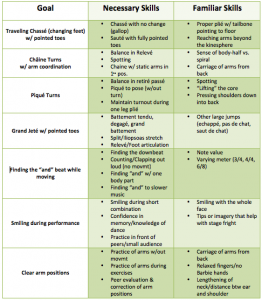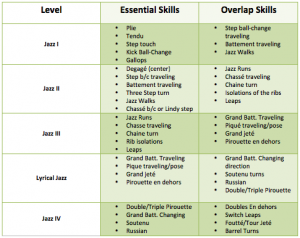When I visit forums or other areas online where dance teachers congregate, I find many questions regarding how to plan lessons and design curriculum. There are certainly a variety of methods for doing both and many teachers work from a codified syllabus. For those of you who may be searching for new ideas or needing some pointers in outlining your own lessons or program of study, I am sharing my methods for doing so.
Lesson Plans will be discussed in Part Two of this series.
Designing Curriculum
Approach for Young Children
 There are many approaches to teaching young children, in all methods the objectives are generally the same: To introduce and practice age-appropriate movement skills, to prepare students for working and functioning within a classroom environment, and to instill a love of dance. Though it can vary, young children generally reach similar levels of motor skill, muscular, and cognitive development at or around the same time. If you are planning a curriculum for these younger age groups it is essential that you have some familiarity with childhood development. Pushing students to perform skills that are beyond their muscular control can damage their bodies.
There are many approaches to teaching young children, in all methods the objectives are generally the same: To introduce and practice age-appropriate movement skills, to prepare students for working and functioning within a classroom environment, and to instill a love of dance. Though it can vary, young children generally reach similar levels of motor skill, muscular, and cognitive development at or around the same time. If you are planning a curriculum for these younger age groups it is essential that you have some familiarity with childhood development. Pushing students to perform skills that are beyond their muscular control can damage their bodies.
Mastery Approach
After age six or seven, age-appropriateness on many levels is no longer as crucial (exceptions would be pointe work or other extreme physical activities prior to growth maturity, appropriateness of choreography and music subject matter). Instead, development is better measured through prerequisite skill mastery. Though advancement may occur at different speeds, a new student at 15 begins and progresses in much the same way a seven-year-old who is new to dance does. Designing a curriculum, then, becomes more about appropriate sequence of learning.
Moving Backward
 When designing short-term curriculum, I generally work backward. In other words, I begin with the goal, the endpoint, the ideal, and then decide how to get there. If I am designing curriculum for a workshop the aims may be fewer and less grand than if I’m planning curriculum for a full year of study.
When designing short-term curriculum, I generally work backward. In other words, I begin with the goal, the endpoint, the ideal, and then decide how to get there. If I am designing curriculum for a workshop the aims may be fewer and less grand than if I’m planning curriculum for a full year of study.
Let’s say one of my final goals is to present a dance, I try to decide which skills I’d like to include or which performance qualities I’d like to see, and give special attention to these in the classes leading up to the performance. In fact, for ease in preparation, I often create entire phrases or combinations of movement for class with the intent that these (or something very similar) will go directly into a final performance work. I do the same in lesson planning, making sure to include exercises featuring movements found in the final combination.
This backward method of planning is not that original. After all it is difficult to figure out how to get somewhere until you know where you are going. The whole idea may even seem obvious but it is a process that I’ve neglected myself at times (regretfully). If you’ve ever found yourself trying to pound a skill into your students and wondering why they are not improving, this is a good time to reassess your goals and determine if perhaps they’ve missed some key building blocks along the way!
To build curriculum for a class or course of study, ask yourself the following questions:
- What do I want the students to be able to do by the end of the year(s)/month/semester/session?
- What skills are necessary to reach each of the above goals? (List them all, even obvious ones)
- What skills must the students have familiarity with (if not mastery of) to accomplish these goals?

The above image contains samples of various goals. Your opinions and experiences may often dictate what is considered necessary, though some skills have inherent prerequisites.
Moving Forward
When I’m working on curriculum that spans multiple years of training, I often work in a more progressive manner, though the end goals are always in the back of my mind:
- I list skills in the order I think they should be learned (including variations like facing barre, then one-hand on barre, then from 5th position, then in center, etc.)
- Then, I place these skills in two columns, according to level: Essential and Overlap. Essential Skills are those requiring mastery in order to move on to the next level. Overlap Skills are those of which students are developing a working knowledge. Overlap usually appear in the Essential column of subsequent levels.

Abstract Skills
Some skills are more abstract than others (for instance musicality, performance quality, etc.) but I like to consider these when focusing on curriculum planning – setting a few goals in these areas which I will strive to incorporate into daily/weekly classes. I do this simply because I don’t want to forget them. They may seem obvious to me but not to a less experienced dancer. “They” say that certain things can’t be taught – but I believe even these less tangible skills can be improved through thoughtful practice and encouragement.
*These tables are not intended to be used as curriculum. They are just rough examples of how a chart might look. Your curriculum would be more thoroughly planned and would probably make more sense!
Have you ever designed your own curriculum? How did you go about it? Can you think of other methods or tips to share with readers?
Nichelle Suzanne is a writer specializing in dance and online content. She is also a dance instructor with over 20 years experience teaching in dance studios, community programs, and colleges. She began Dance Advantage in 2008, equipped with a passion for movement education and an intuitive sense that a blog could bring dancers together. As a Houston-based dance writer, Nichelle covers dance performance for Dance Source Houston, Arts+Culture Texas, and other publications. She is a leader in social media within the dance community and has presented on blogging for dance organizations, including Dance/USA. Nichelle provides web consulting and writing services for dancers, dance schools and studios, and those beyond the dance world. Read Nichelle’s posts.

